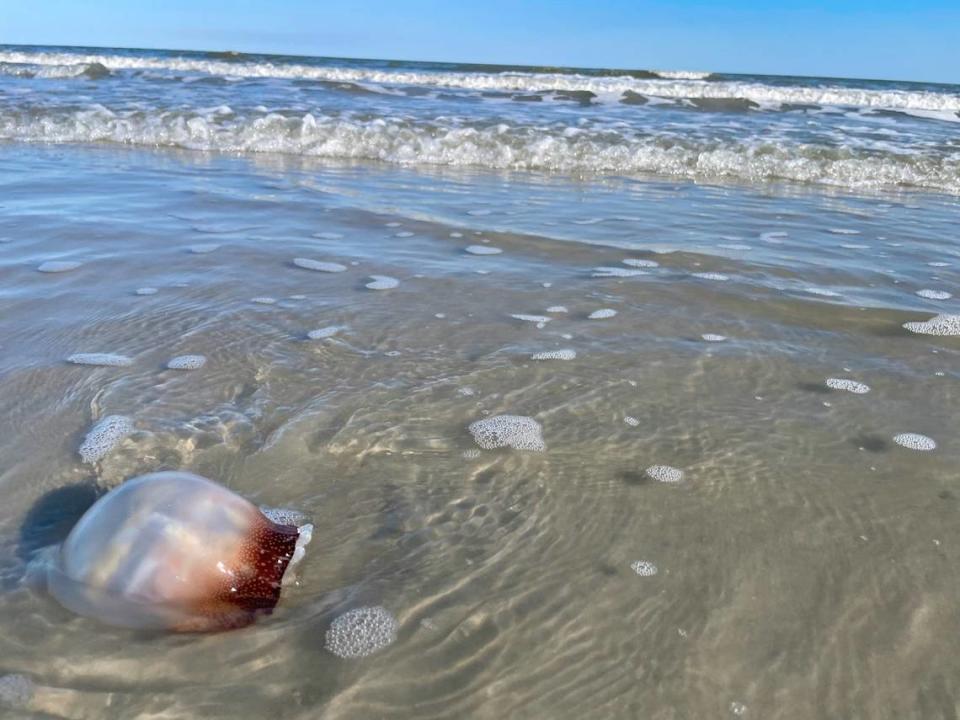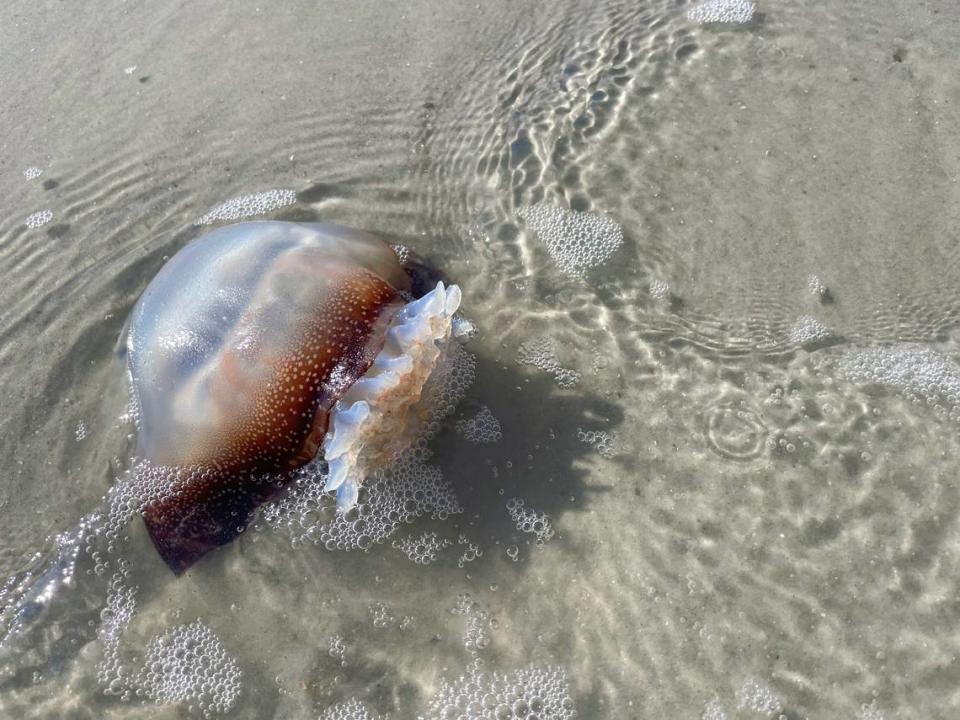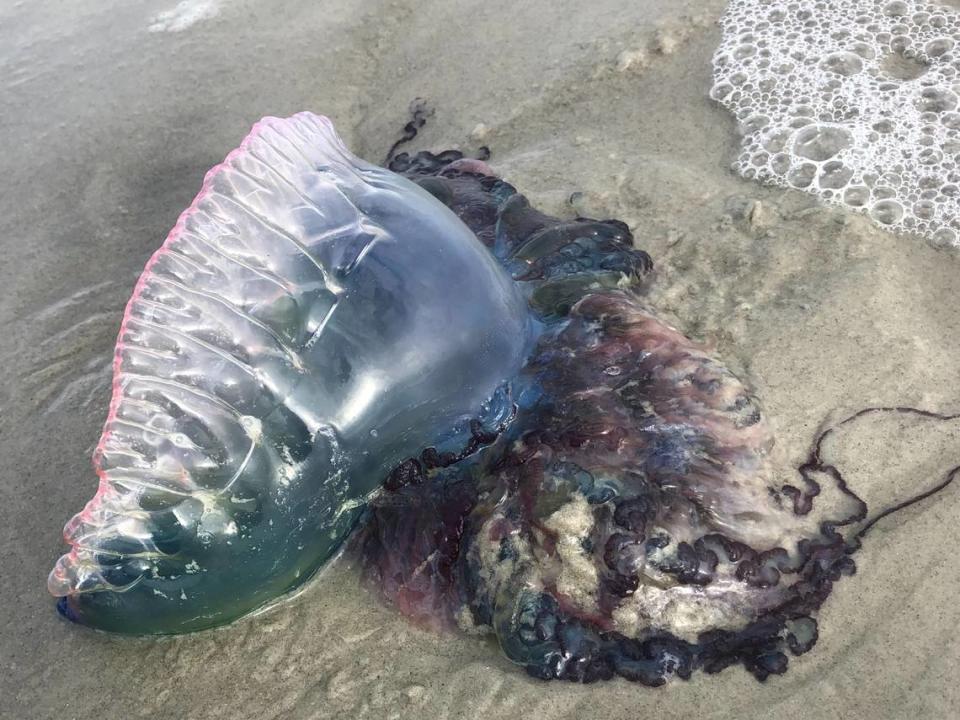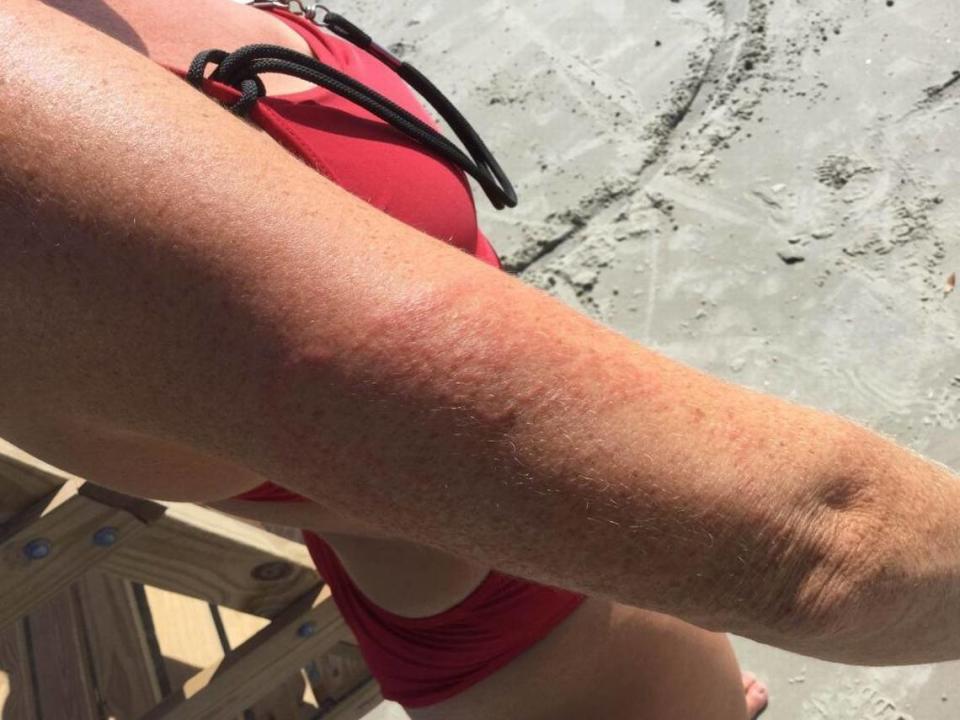Jellyfish will soon swarm Hilton Head beaches. Here’s why and what to do if you get stung
Have you had the chance to head out to any part of Hilton Head Island’s 12 miles of white sand beaches lately?
If so, you may notice some beached jellyfish that have washed ashore.
With the weather warming up, the number of jellyfish stranded or floating among the surf will be on the rise once again.
The phenomenon is natural, tends to happen yearly and can even be expected by locals most of the time, but it’s understandable that the scattering of dead jellies on the shore and many more floating in the shallow surf can be alarming or even off-putting to many beachgoers.

What are they?
Have you ever been curious about the dome-shaped, tentacled creatures floating through the water?
Although the term jellyfish may come to mind, that’s not the proper name to call them.
“Jellyfish are not really fish, of course, because a fish’s anatomy is centered around its backbone, whereas the jellyfish is a dome-shaped invertebrate. Therefore, it’s more accurate to refer to them simply as ‘jellies,’” states the Florida Keys National Marine Sanctuary through the National Oceanic and Atmospheric Administration.
In fact, these roving creatures are actually most closely related to corals, sea anemones, sea whips and hydrozoans.
What type of jellies does Hilton Head Island have?
Frequently, the most commonly found jelly seen around Hilton Head’s shores and around South Carolina is the cannonball jelly. Luckily for many avid beachgoers, this round, smaller-sized jelly generally does not sting and poses no large threat to curious or nearby families.
However, this isn’t the only species you might find in the area.
“We have several species that occur in our waters beside the cannonball/cabbagehead, however, you locally want to call it,” Dr. Joe Staton of the Department of Natural Sciences Chair at the University of South Carolina Beaufort, has said to The Island Packet.
“There’s also sea nettles which are kind of moon jellies that occur worldwide. We get those here. We get Portuguese man o’ war which are not actually in the same group as the jellies with the bells.”
Cannonball jellies are abundant along the coast of South Carolina. If you find one dead on the beach, it’s common to find them without most of their color, as this tends to occur soon after they wash ashore. Some people even accidentally step on them while on the beach without realizing and end up getting a slippery surprise.

Once stranded on the beach, cannonball jellies can’t survive long out of the water and eventually become a food source for shorebirds, crabs, sea turtles and other critters that live along the coast. These jellies are also a favored snack for the endangered leatherback sea turtle and provide nourishment for the visiting mothers and soon-to-be hatching eggs in the future.
Another sea turtle species that visits the area and feeds on these jellies is the loggerhead sea turtle. They are the most common kind of sea turtle to use the shores of Hilton Head Island as their nesting ground, according to hiltonheadisland.org.
Aside from cannonball jellies, sea nettles can be found off the island’s coast and in the surf. These jellies are responsible for the most stings on Hilton Head Island, with the most recorded stings in one day being in the hundreds.
Another one that can be found in the area is the Portuguese man o’ war. Even though it may resemble a jelly, the Portuguese man o’ war is what is known as a siphonophore and appears bluish-purple in color.

If you come across one on the beach or in the surf, it appears similar to an inflated plastic bag.
“The important thing about the Portuguese man o’ war, if they’re washed up on the beach, they’re like dead bees. They can still sting you, so don’t mess with them,” Staton had said.
The best advice when around these multitudes of dead jellies is to not directly touch a dead jellyfish if you don’t know what kind it is.
Why are there sometimes so many jellies washed ashore at once?
In most cases, jellies travel in groups called “blooms.”
These assemblies tend to form in a short amount of time after the population expands following a rise in water temperatures, as they prefer and thrive in warmer waters. Thus, these clusters tend to form and follow the spring and summer months.
Rough winds, storms, swells, tides and currents can send the jellies to shore, which in certain events can happen all at once. A cooling of the water temperatures can also contribute to mass deaths of the jellies that will eventually get washed ashore or consumed.
How to tell if you’ve been stung
Not sure if you’ve come across a floating jelly or stepped on one on the beach and have been stung? Always consult with a lifeguard if one is nearby or evaluate the potential sting area yourself if you know what to look for.

According to Mayo Clinic, common signs that you’ve been stung by a jellyfish include:
Burning, prickling or stinging pain
Red, brown or purplish tracks on the skin — a “print” of the tentacles’ contact with your skin or tentacles that may broken off and stuck to the skin itching
Swelling
Throbbing pain that radiates up a leg or an arm
What to do and not do if you think that you’ve been stung
“Diagnosing jellyfish stings generally doesn’t require a visit to a health care provider. If you do go, your provider will likely be able to diagnose your injury by looking at it,” reported Mayo Clinic.
Mayo Clinic states that most jellyfish stings, unless severe symptoms are also present, can be treated by:
Carefully plucking visible tentacles from the skin with fine tweezers
Soaking the skin in hot water. Use water that’s 110 to 113 F. It should feel hot, not scalding. Keep the affected skin immersed or in a hot shower until the pain eases, which might be 20 to 45 minutes
Apply 0.5% to 1% hydrocortisone cream or ointment twice a day to the affected skin In addition, there are many widely spread tales of how to “help” someone who’s been stung that are actually incorrect
Mayo Clinic also listed these actions to avoid as they are unhelpful or remain unproved to provide aid.
Scraping out stingers
Rinsing with human urine
Rinsing with cold, fresh water
Applying meat tenderizer
Applying alcohol, ethanol or ammonia
Rubbing with a towel
Applying pressure bandages

